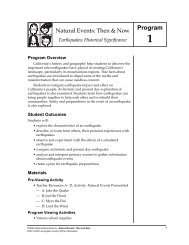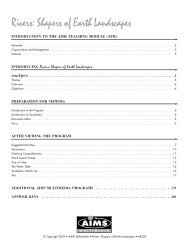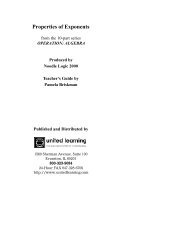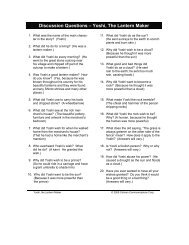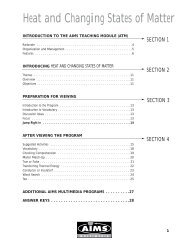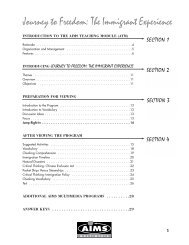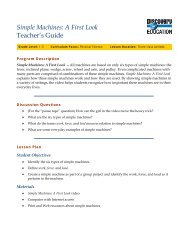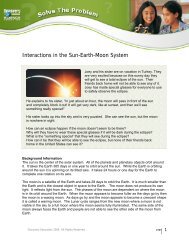Climate, Landscapes and Life: The Tropics - Discovery Education
Climate, Landscapes and Life: The Tropics - Discovery Education
Climate, Landscapes and Life: The Tropics - Discovery Education
Create successful ePaper yourself
Turn your PDF publications into a flip-book with our unique Google optimized e-Paper software.
<strong>Climate</strong>, <strong>L<strong>and</strong>scapes</strong> <strong>and</strong> <strong>Life</strong>: <strong>The</strong> <strong>Tropics</strong><br />
<strong>The</strong>mes<br />
Objectives<br />
Introduction to Vocabulary<br />
Earth’s climatic regions, natural vegetation,<br />
habitats, <strong>and</strong> human modification of the<br />
l<strong>and</strong>scape are major themes in Geography<br />
<strong>and</strong> Earth Science curriculums. In <strong>Climate</strong>,<br />
<strong>L<strong>and</strong>scapes</strong> <strong>and</strong> <strong>Life</strong>: <strong>The</strong> <strong>Tropics</strong>, students<br />
will visit the world’s many tropical regions,<br />
learn the climatic influences that shape each<br />
of them, <strong>and</strong> gain insight into the human cultural<br />
history of the various locales.<br />
Overview<br />
<strong>The</strong> Earth’s tropics lie in l<strong>and</strong>s near the equator<br />
whose climatic regions are based on<br />
their latitude, altitude above sea level, <strong>and</strong><br />
the seasonality <strong>and</strong> amount of precipitation<br />
they receive. <strong>The</strong>se regions have very little<br />
seasonal change in temperature <strong>and</strong>, at<br />
lower elevations, are always warm.<br />
Students will learn the locations of tropical<br />
regions around the globe, the factors of climate<br />
<strong>and</strong> geography that shape each<br />
region, their natural vegetation, habitats,<br />
<strong>and</strong> human-modified l<strong>and</strong>scapes. Regions<br />
through which this program guides students<br />
include the rainy tropics, the wet-dry <strong>and</strong><br />
monsoon tropics, tropical <strong>and</strong> subtropical<br />
deserts, <strong>and</strong> tropical highl<strong>and</strong>s. <strong>The</strong>se are<br />
illustrated by such locales as lush, humid<br />
rainforests filled with arboreal wildlife,<br />
highly industrialized cities, <strong>and</strong> the world’s<br />
largest desert. In addition, students learn<br />
geographical terms that help them identify<br />
<strong>and</strong> locate the various regions, <strong>and</strong> to<br />
underst<strong>and</strong> processes integral to different<br />
tropical locales. <strong>The</strong> human geography of<br />
these diverse l<strong>and</strong>s is represented through<br />
the agricultural activities, styles of architecture,<br />
livelihoods, h<strong>and</strong>icrafts, music <strong>and</strong> cultural<br />
traditions found in each region.<br />
• To show the geographical locations of the<br />
various tropical regions around the world<br />
• To provide an overview of the natural vegetation,<br />
wildlife habitats, <strong>and</strong> humanmodified<br />
l<strong>and</strong>scapes found in the world’s<br />
major climatic zones<br />
• To examine the practice of shifting cultivation<br />
employed in the rainforests of the<br />
rainy tropics, <strong>and</strong> its effect on the natural<br />
vegetation of the region<br />
• To illustrate the seasonal patterns of rainfall<br />
<strong>and</strong> drought that govern the climates<br />
of the wet-dry <strong>and</strong> monsoon tropics<br />
• To explore the areas of human population<br />
in the tropics <strong>and</strong> the different types of<br />
l<strong>and</strong> use employed by that population<br />
• To illustrate the role that altitude plays in<br />
determining climate<br />
Introduction to the Program<br />
To prepare students for, <strong>Climate</strong>s,<br />
<strong>L<strong>and</strong>scapes</strong> <strong>and</strong> <strong>Life</strong>: <strong>The</strong> <strong>Tropics</strong>, discuss<br />
with them what comes to mind when they<br />
think about regions called “the tropics.”<br />
Write on the board any ideas generated by<br />
the group; expect them to include such<br />
descriptions or items as:<br />
heat, humidity, rain, sunshine, the equator,<br />
palm trees, s<strong>and</strong>y beaches, the Pacific, the<br />
Caribbean, Hawaii, Florida, isl<strong>and</strong>s, hurricanes,<br />
rainforest, tropical fruits, endangered<br />
species<br />
Discuss the list with the class. Explain that<br />
they will be viewing a video in which they<br />
will see many of the things they mentioned,<br />
along with additional facts <strong>and</strong> details about<br />
the tropical regions of the planet.<br />
Write the following words on the board <strong>and</strong><br />
explain that they will be referenced in the<br />
video. Some students may be unfamiliar with<br />
the terms. If the meaning of any word is<br />
unclear to the group, ask volunteers to use<br />
an appropriate reference source to check the<br />
term <strong>and</strong> report their findings to the class.<br />
alluvial, arboreal, climate, exotic river, monsoon,<br />
montane, savanna, seasonality, selva,<br />
shifting cultivation<br />
Discussion Ideas<br />
Lead students in a discussion of how the climates<br />
in the tropical regions affect the living<br />
organisms found there. Ask them to consider<br />
the types of adaptations necessary to survive<br />
in the rainy tropics, or in a tropical desert.<br />
What adjustments do they think they would<br />
have to make to their lifestyle if they were<br />
suddenly transported to a climate radically<br />
different from their current one What<br />
human-generated modifications to their<br />
environment do they know of Which do<br />
they believe to be justified, <strong>and</strong> which - if<br />
any - do they think may not be justified with<br />
regards to their effect on the environment<br />
Focus<br />
Ask students to think for a few moments<br />
about the climate <strong>and</strong> l<strong>and</strong> use in your community<br />
<strong>and</strong> in your state. How do they think<br />
those things impact the region <strong>and</strong> their<br />
lives Tell them to keep these thoughts in<br />
mind as they view the program <strong>and</strong> to determine<br />
for themselves how the climate <strong>and</strong><br />
l<strong>and</strong> use in the various tropical regions<br />
impacts the living organisms found there. Let<br />
them know you will discuss these <strong>and</strong> other<br />
aspects following the screening.<br />
6<br />
© Copyright 2002 • AIMS Multimedia • <strong>Climate</strong>, <strong>L<strong>and</strong>scapes</strong> <strong>and</strong> <strong>Life</strong>: <strong>The</strong> <strong>Tropics</strong> • #2650



